Exploring the Dynamics of Wind Foil Kites in Kiteboarding
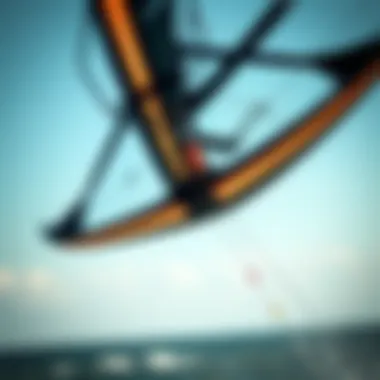
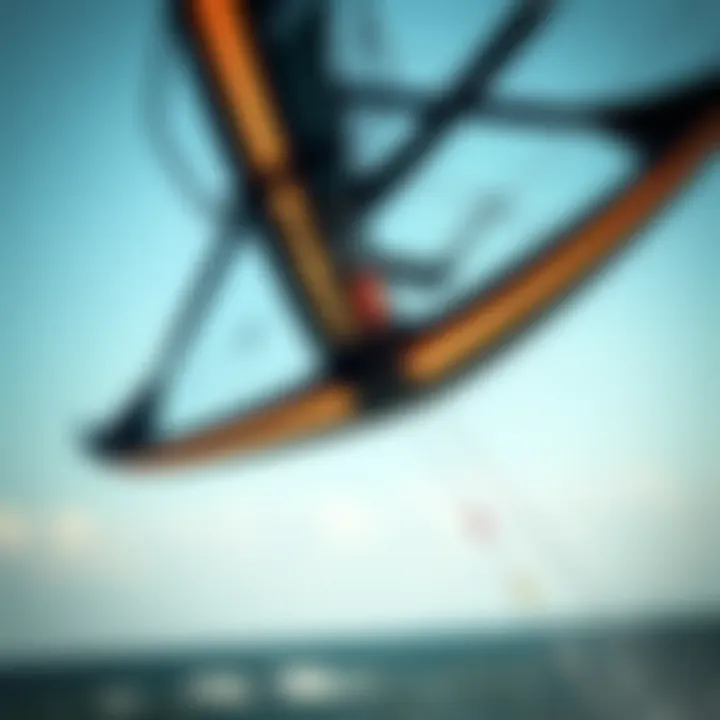
Intro
Wind foiling has surged in popularity in recent years, morphing a once niche pastime into a mainstream thrill. For both veterans and newcomers venturing into the realm of kiteboarding, the marriage between wind dynamics and hydrofoil technology has created a fluid, exhilarating experience on the water. This exploration delves into the mechanics of wind foil kites and their design, illuminating their revolutionary impact on the kiteboarding world. From understanding the intricate relationship of gear and techniques to the safety practices vital for an enjoyable ride, this guide aims to empower enthusiasts at every level. Let's take a deep dive into this invigorating sport, connecting the past with the future of wind foiling, and uncovering what makes it so captivating.
Gear and Equipment
Choosing the right gear is pivotal in mastering kiteboarding, especially when it comes to wind foiling. Selecting equipment tailored to skill level and conditions can significantly enhance the overall experience.
Essential Kiteboarding Gear for Beginners
For those just dipping their toes in the water, familiarizing with the essentials is the first step:
- Kite: Look for a beginner-friendly model, such as the Cabrinha Switchblade or Liquid Force Envy, which offer stability and ease of handling.
- Control Bar: A simple, durable control bar like the Naish Control System is pivotal.
- Harness: Opt for a comfort harness that supports your back without restricting movement.
- Safety Gear: A helmet and impact vest are necessary for protection.
- Board: A larger, stable board makes learning easier. Consider the Slingshot Misfit for its forgiving ride.
Advanced Equipment for Experienced Riders
Once you’ve mastered the basics, it’s time to invest in high-performance gear:
- High-Aspect Foil Setup: The Lift Foils Infinity series suits experienced riders, allowing for greater speeds and efficiency.
- Kite Design Innovations: The Ozone Enduro features versatility that supports varying conditions.
- Advanced Control Systems: Look for systems with adjustable settings, like the Duotone CLICKBAR, for a more tailored experience.
- Specialty Boards: A dedicated foil board, such as the Fanatic Sky, promotes advanced maneuvers.
Techniques and Tips
Mastering techniques and understanding the ins and outs of kiteboarding can considerably heighten enjoyment and safety factors.
Safety Practices for Kiteboarding
Safety should never get thrown by the wayside. Here are some key practices:
- Review Conditions: Always assess wind and water conditions before heading out.
- Buddy System: Kite with a partner; it’s a good way to keep an eye on each other.
- Know Your Gear: Familiarize yourself with your equipment, especially the release systems.
- Emergency Protocols: Prepare for emergencies; practice how to self-rescue and handle unexpected situations.
Training Techniques to Improve Your Skills
Upgrading your skills can be achieved via various methods. Consider the following:
- Regular Practice: Consistency is key. Try to get out on the water as often as possible.
- Join a Class: Learning from a qualified instructor can make a world of difference.
- Video Analysis: Record your sessions to critique and improve your technique.
- Engage with the Community: Seek advice and tips from peers, either through local meet-ups or forums on platforms like Reddit or Facebook.
"The best surfer out there is the one having the most fun." - Phil Edwards
As kiteboarding continues to evolve, understanding the gear and techniques becomes increasingly crucial. Whether you're just starting or looking to refine your skills, this journey into wind foiling is just beginning, promising thrills, challenges, and endless opportunities to connect with nature.
For further references and in-depth reading, visit Wikipedia, Britannica, or dive into community discussions on Reddit. It is necessary to stay updated with new advancements and strategies that energize this dynamic sport.
Prelims to Wind Foil Kites
Wind foil kites represent a captivating intersection of technology and nature. These sophisticated devices harness the power of wind to offer an unparalleled experience in kiteboarding. Understanding the ins and outs of wind foil kites is essential for anyone looking to enhance their skills or simply enjoy the thrill of flying across water.
The topic of wind foil kites is not just about the exhilaration they provide; it's about the unique benefits they bring to the kiteboarding community. Wind foil kites allow riders to glide smoothly over water, often enabling the experience of riding in lighter winds where traditional kites might struggle. This means less dependence on substantial wind speeds, opening up a world of possibilities for maneuverability and exploration.
In this section, we will delve into several facets of wind foil kites, covering their definitions, the dynamics that drive their operation, and the vital role they play in transforming the kiteboarding experience. By addressing these elements, we lay a solid foundation for understanding how these innovative kites function and the enjoyment they offer to both novices and seasoned pros alike.
Defining Wind Foil Kites
Wind foil kites are specially designed kites outfitted with foils that lift the rider above the surface of the water. Unlike traditional kites that primarily rely on surface friction, these kites achieve a lift that allows for cutting through the water with minimal drag.
Typically, a wind foil kite comprises multiple components working in harmony:
- The Kite: Engineered for lift and stability.
- Foil: This is crucial; it lifts the kite rider out of the water, allowing for a fluid riding experience.
- Control Bar: Lets the rider control the kite’s position and power.
Although the concept of foiling has existed for some time, its application in kiteboarding has revolutionized the sport. This is not merely a gimmick; it dramatically alters how kiteboarders engage with both the wind and the water, pushing the boundaries of what is possible.
Understanding Kiteboarding Dynamics
The dynamics of kiteboarding are rooted in principles that might seem complex but can be broken down for easier understanding. When you steer a wind foil kite, you effectively manipulate three main aspects: lift, drag, and control.
- Lift: This is the upward force generated by the kite in the wind. The angle of attack plays a critical role; too steep a position could stall the kite, while too shallow could result in insufficient lift.
- Drag: Resistance encountered as the kite moves through the air. Minimizing drag is crucial for maximizing performance, especially when foiling.
- Control: How well a rider manages these forces determines their performance and enjoyment. Knowing when to pull on the control bar, shift body weight, or adjust stance profoundly impacts maneuverability.
Understanding these factors can lead to a more enjoyable riding experience. It allows riders to harness the wind more effectively, ensuring they maintain stability while also achieving those exhilarating speeds that make kiteboarding so appealing. Kite designers continually refine these dynamics to produce kites that can withstand diverse weather conditions, which is a game-changer for adventurous spirits craving new challenges on the open water.
Historical Background of Kiteboarding
Understanding the historical backdrop of kiteboarding is crucial to appreciate its development and impact today. This sport, which blends the thrill of surfing with the art of flying a kite, has transformed remarkably since its inception. Going from humble beginnings to a global phenomenon, the evolution of kiteboarding showcases human innovation, passion, and the desire for adventure. Knowing where it all began allows riders to better relate to the equipment they use and the techniques they apply.
The interplay of wind and water with a kiteboard has roots in various cultures. Notably, during the 13th century, Chinese fishermen utilized kites for propulsion while rowing their boats. The dynamics of harnessing wind through fabric and cord laid the groundwork for modern kite sports. By tracing this lineage, one can appreciate how the technology used in kiteboarding has progressed. The history weaves a connection not only to advancements in materials but also to shifts in societal attitudes toward extreme sports.
"Every time you take to the water with a kite, you’re part of a rich tapestry woven through countless eras and cultures."
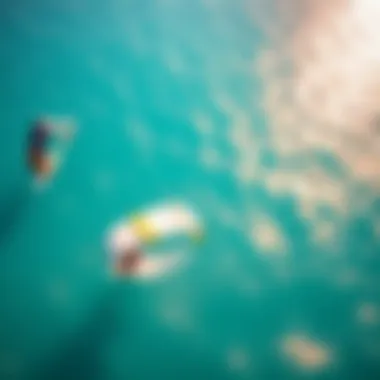

Early Kite Designs and Innovations
In the early days, kites were primitive as compared to today’s cutting-edge designs. Early kites were typically simple structures made from bamboo, silk, and paper. These materials were not resilient against harsh weather or the vigorous demands of a water sport. However, the fundamental principles of flight were understood, paving the way for adaptation.
In the 1960s and 1970s, modifications began to surface. The creation of the first inflatable kites marked a pivotal moment. Built using nylon materials, these kites were light and could hold shape, which made them much easier to control. Riders started to experiment with different designs, leading to variations that focused on speed and agility over mere stability.
The kite's design also began to incorporate notions of lift more significantly. Early innovations like the traction kite showcased a new functionality; suddenly, the kite wasn’t just about aerial display, but about harnessing wind to propel oneself across water.
- Key early innovations included:
- The introduction of leading edge inflatable kites.
- Development of various shapes and sizes to improve performance.
- Experimentation with materials for wind resistance and durability.
This green-lighted a journey into the world of kiteboarding as we know it today. It wasn't overnight, but little by little, an avid community of kiteboarders pushed the limits of what a kite could do and how it could be used on water.
The Evolution of Foil Technology
As kiteboarding grew in popularity, a technological leap was on the horizon. Enter the foil kite—a revolutionary design that uses a closed cell structure to create a streamlined appearance, improving aerodynamics and efficiency in the air. The design of a foil allows it to stay airborne with less wind than regular kites, offering a delightful shift in riding experience.
The evolution of foil technology began in the 1990s and marked a bold step forward. From early designs that focused primarily on performance, the technology now caters to safety, ease of use, and versatility across different water conditions. With various sizes and styles available, riders can find foils that match their preferences—whether for speed, stability, or agility.
In recent years, vendors have increased their focus on developing environmentally-friendly materials for kites, making significant strides toward sustainability. Now, more than ever, there’s an effort to create equipment that benefits both riders and the environment.
- Current key advancements include:
- Adoption of lightweight and durable fabrics to improve overall kite efficiency.
- Enhanced control systems allowing for easy maneuverability and better performance.
- Increased focus on creating kites that minimize environmental impact,
Reflecting on these epochs of development reveals much about kiteboarding’s adaptability and growth. Each chapter of its history not only reflects the spirit of adventure but also serves as a foundation upon which current and future innovations rest.
Mechanics of Wind Foil Kites
The mechanics of wind foil kites encompass the scientific principles that not only allow these kites to function effectively but also enhance the overall kiteboarding experience. Comprehending how these mechanics operate is essential for both new and experienced riders as they directly influence everything from maneuverability to speed. In a sport where precision is paramount, understanding the intricate relationship between forces and movements can transform a good ride into a great one.
When you think about it, these mechanics boil down to three main factors: aerodynamics, hydrodynamics, and stability control. Each component interplays delicately with the others, much like a symphony, creating a harmonious experience for the rider. Let’s break down these aspects further.
Aerodynamics and Lift
Aerodynamics is the backbone of a wind foil kite's performance. Essentially, this field examines how air interacts with moving objects—like the kite itself. When a kite is thrown into the wind, it shapes the airflow around it. This creates lift, enabling it to ascend. For wind foil kites, the aerodynamics take on added importance because they not only need to stay aloft but also glide seamlessly on water.
Several factors influence aerodynamics:
- Shape of the Wings: A well-designed wing shape ensures that air travels smoothly over the surface, reducing drag and increasing lift.
- Angle of Attack: This refers to the angle between the wing and the oncoming air. A slight increase can dramatically improve lift but can also lead to stalling if taken too far.
- Speed of the Wind: More wind generally equates to more lift; however, experienced riders know that the magic happens at just the right velocity.
Understanding these principles not only improves performance but also enhances safety on the water.
Hydrodynamics: The Role of Water Interaction
Hydrodynamics, on the other hand, looks at how the kite interacts with the water surface. This becomes incredibly important since wind foiling involves the kite lifting above water, necessitating a detailed grasp of how forces play out below. This can be particularly challenging for newcomers to the sport.
Key elements include:
- Lift Generated by the Foil: When a rider accelerates across water, the foil submerged beneath the board generates lift by displacing water. This requires a delicate balance; too much lift can send the rider soaring, while too little can result in a crash landing back on the surface.
- Drag: Unlike air, water is denser, leading to different challenges. Riders must account for drag from the water, which can inhibit speed if not managed properly.
- Surface Conditions: Smoother surfaces allow for easier gliding, while choppy waters require advanced techniques to keep the kite flying efficiently. Knowledge of hydrodynamics can help make or break a session.
Stability and Control Mechanisms
Stability in wind foiling is akin to having a well-tuned engine. If a kiteboarder lacks stability, they’ll struggle to maintain control and perform tricks. The kite needs to sit at the right angle, and a rider must use their body weight wisely to counterbalance shifts in wind and water.
Factors influencing stability encompass:
- Kite Design: Kites that are inherently stable will allow riders to focus more on their performance rather than fighting against the kite.
- Control Bars and Lines: These components are the lifeline during rides. They help modulate the kite’s movements and maintain consistent control over direction and height.
- Rider's Positioning: Knowing how to position oneself effectively while adjusting to changing forces is crucial. Small tweaks in weight distribution can lead to significant changes in stability.
Understanding these mechanisms offers kiteboarders not just a technical advantage but also a deeper appreciation of the sport. The dance of wind through the kite, the glide over water, and the subtle shifts of balance form an intricate tapestry of experience that defines kiteboarding.
"Mastering the mechanics is not merely about physics; it is about feeling the rhythm of nature and riding it with grace."
In navigating the waters, an understanding of wind foil kite mechanics can ensure both exhilarating rides and safe practices, home to a blend of art and science.
Key Components of Wind Foil Kites
Understanding the key components of wind foil kites is crucial for anyone looking to engage with this thrilling sport. Each element not only serves a unique function but also enhances the overall experience, ensuring that kiteboarders can utilize the full potential of the wind and water. This section will break down the fundamental aspects of wind foil kites, emphasizing the materials used, the intricacies of foil design, and the importance of control systems.
Kite Material and Structure
The choice of material and the structure of the kite can significantly influence performance and durability. Most modern kites are crafted from high-tenacity nylon or polyester fabrics. These materials are designed to withstand strong winds while being lightweight enough for easy maneuverability.
When we consider kite structure, the frame plays a vital role in maintaining shape against the aerodynamic forces during flight. A rigid yet flexible frame helps the kite perform optimally, reducing drag and enhancing lift. The construction methods, such as seam technologies and reinforcement points, determine how well the kite can handle rough conditions without succumbing to wear or tear.
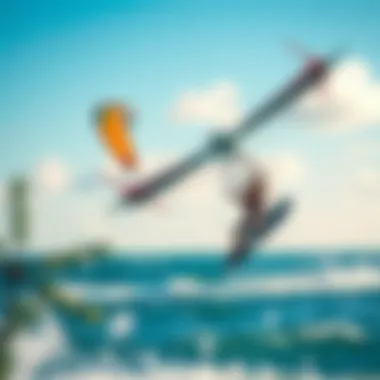
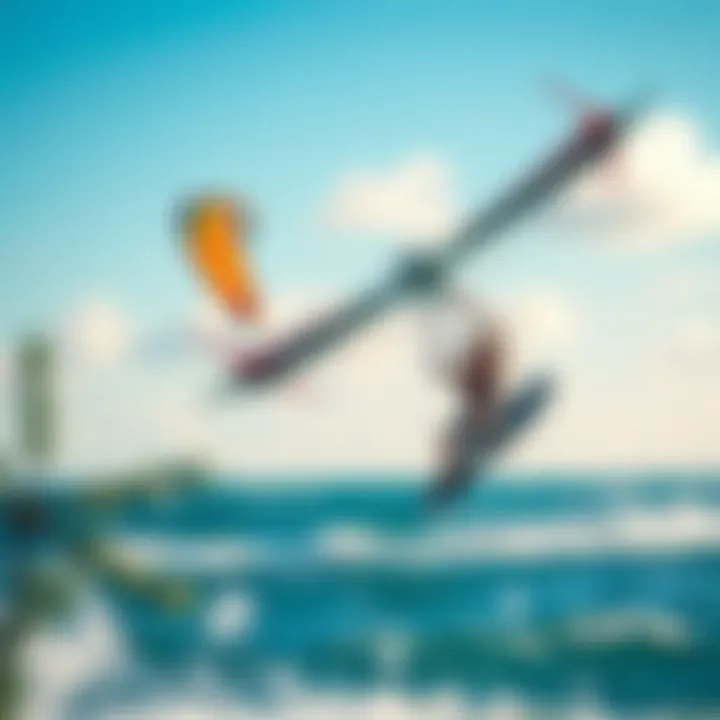
Additionally, the shape of the kite can vary based on its intended use. A flatter kite might work wonders for speed, while a more pronounced design can facilitate better lift and stability, especially for new riders. As a kiteboarder, considering these elements can guide decisions on what setup best matches individual skill level and riding style.
Foil Characteristics and Design
Foil kites distinguish themselves from traditional kites mainly through their unique design. These kites usually come with an airfoil shape that actually creates lift by harnessing wind flow effectively. Unlike typical kites that rely principally on wind pressure, the design of the foil allows for smoother flights and control.
A key aspect to consider is the aspect ratio of the foil. Kites with a high aspect ratio tend to be faster and offer more efficiency but can be trickier to handle for beginners. Lower aspect ratios are generally more stable and forgiving, making them ideal for new kiteboarders.
Subtle features, such as canopy tension and shape, greatly affect performance. Adjustments to winglets or the curvature of the leading edge can yield quite remarkable differences in response and stability during flight. Knowledge about these characteristics enables riders to make informed choices tailored to their specific conditions and preferences.
Control Bar and Lines: Their Importance
The control bar and lines are arguably the unsung heroes in the entirety of kiteboarding gear. This system acts as the direct interface between rider and kite, channeling inputs into exact movements in the sky and water. A well-crafted control bar promotes comfort and ensures precision in handling the kite.
Usually constructed from lightweight, durable materials, the bar allows for easy adjustments in length, often suited for various skills and body types. Furthermore, the quality of the lines – typically made from spectra or dyneema – affects the responsiveness of the kite. Thicker lines might offer greater durability but may not provide the same sensitivity as thinner counterparts.
The effectiveness of communication between bar and kite hinges on the quality of these components. A rigged control system can lead to accidents, while a properly optimized system keeps the adventure free of worry.
Ultimately, understanding these components beforehand creates a safer and more enjoyable experience. Kiteboarders, whether beginners or seasoned professionals, can appreciate how these exquisite instruments can turn the power of the wind into exhilarating athletic art.
Techniques for Operating Wind Foil Kites
Operating wind foil kites is a nuanced art that melds skill, intuition, and understanding of the elements. As any experienced kiteboarder will tell you, mastering these techniques can make the difference between a thrilling ride and a challenging day out on the water. With an ever-changing wind and water surface, knowing how to launch, land, maneuver, and perform tricks with a wind foil kite becomes essential. This section highlights the fundamental techniques necessary for operating these kites effectively, ensuring not only a safer ride but an enhanced experience overall.
Launching and Landing Techniques
Launching and landing a kite are two of the most critical maneuvers in the kiteboarding discipline. A proper launch sets the stage for a successful session, while a safe landing ensures that you exit with style, rather than crashing hard.
- Preparation: Ensure that your wind foil kite is correctly assembled and ready to go. Check for any damage on the lines and make sure your safety gear is in place.
- Launch Position: It’s best to have your kite at a 45-degree angle to the wind. This position gives you maximum control when it’s time for liftoff.
- Launching with Assistance: If you're new, having a buddy to assist can be invaluable. They can help to hold the kite while you walk backward, creating a tension that lets the kite catch the wind more easily.
- Landing Techniques: To land, slowly bring the kite closer to the center of the window and lower it to around 12 o'clock as you prepare to touch down. Keep an eye out for changing winds; a soft landing is always safer.
"A smooth launch is like a gentle breeze at your back; it should feel effortless, but only comes with practice."
Turning and Maneuvering Techniques
Maneuverability is key when it comes to enjoying wind foiling. It’s not just about going straight; it's about mastering the turns, which can be a dance between kite and rider.
- Body Positioning: Your stance is everything. Keep your knees slightly bent and your weight centered over the board to shift your balance fluidly.
- Kite Steering: Use gentle movements to steer the kite. A strong pull can result in a sudden turn but may also cause loss of control.
- Edge Control: Remember your edges. Press down on your toes when turning upwind while leaning back slightly to prevent a dig in the nose of the board.
- Practicing Slalom Turns: A slalom pattern helps learn timing and balance. Get used to turning both ways, as this will make you a well-rounded rider.
Advanced Jumps and Tricks
Once comfortable with the basics, many riders delve into the realm of jumps and tricks, elevating their kiteboarding experience. A good understanding of technique can lead to impressive performances.
- The Pop: To jump, initiate with a quick downward force on the board followed by a strong upward pull on the kite. Timing and coordination are crucial.
- Staying Compact: While airborne, keep your body compact. This not only helps with control but also makes landing smoother as you prepare to return to the water.
- Trick Variations: Once you have the basic jump down, you can experiment with variations like spins or grabs. Understanding how to shift your weight will help in executing these.
- Safety First: Always be aware of your surroundings and practice in an area free from obstacles or other riders until you feel more confident.
Mastering these techniques requires dedication and practice. With every session, the connection between rider and kite deepens, bringing with it a thrill that is hard to match. For anyone serious about wind foil kites, taking the time to hone these skills is an investment that will pay off in pure excitement and enjoyment on the water.
Safety Considerations in Kiteboarding
Kiteboarding, while exhilarating, can also pose significant risks if proper safety measures are overlooked. The interplay of wind, water, and high speeds necessitates a thorough understanding of safety considerations to mitigate potential hazards. In this context, the following sections will discuss the essentials of kiteboarding safety, including the vital gear required and the importance of well-executed risk assessment.
Essential Safety Gear
When it comes to kiteboarding, the right safety equipment can mean the difference between a delightful day on the water and a dangerous misadventure. Here are some of the must-have items:
- Kite Harness: A good quality harness ensures that the force of the kite is distributed properly, relieving stress on your body while keeping you securely attached to the kite.
- Helmet: Protecting your head isn’t just common sense; it’s essential. Strong winds, errant kite lines, or even a fall can lead to serious head injuries if proper gear isn’t worn.
- Impact Vest: This adds an extra layer of security, cushioning potential impacts with the water or hard surfaces.
- Personal Flotation Device (PFD): While many skilled riders can swim well, wearing a flotation device can prevent panic or fatigue in rough water.
- Safety Knife: In the unfortunate event of entanglement or malfunctioning kite lines, having a knife at the ready can be invaluable.
- Bar and Lines with Quick Release System: This is critical for emergency situations, allowing you to detach from the kite swiftly if necessary.
"Preparation is critical. The more equipped you are, the fewer surprises you face on the water."
These items create a safety net that allows kiteboarders to push their limits while reducing risks. Not only does this gear protect the individual, but it also enhances the overall experience.
Risk Assessment and Management
Being aware of the surrounding environment and your personal skill level is an integral part of safe kiteboarding. A proper risk assessment involves evaluating both immediate and long-term hazards. Here are some key considerations:
- Weather Conditions: Always check the weather before heading out. Look for wind speeds and patterns that can change drastically. Favorable conditions for one person may not suit another.
- Skill Level Consideration: Understand your own limitations. Beginners should opt for mellow water and lighter winds, while advanced riders should seek more challenging conditions but remain aware of the risks involved.
- Environmental Awareness: Be aware of the body of water you plan to kite on. Identify potential hazards such as rocks, shallow spots, or heavy boat traffic. These factors can complicate maneuvers and increase the likelihood of accidents.
- Escape Plans: Know how to get out of tricky situations before they arise. Develop a mental strategy for what to do if your kite becomes uncontrollable or if you find yourself in a tight spot.
- Buddy System: Whenever possible, kite with a partner. Having someone else around can be a lifesaver in emergencies, whether it’s spotting hazards or providing immediate assistance.
In summary, safety in kiteboarding boils down to being proactive. By equipping oneself with the necessary gear and conducting thorough risk assessments, kiteboarders can immerse themselves in the thrill of the sport while minimizing dangers. Preparing for unforeseen circumstances is part of the joy of kiteboarding; it lets enthusiasts enjoy their passion responsibly.
Choosing the Right Wind Foil Kite
Selecting the right wind foil kite is not just about preference; it's a nuanced decision that can significantly affect your overall kiteboarding experience. Whether you are a seasoned rider or someone just starting out, the kite you choose can make all the difference between a thrilling ride and a frustrating session. This section discusses essential elements, benefits, and factors to keep in mind when choosing a wind foil kite.
Factors to Consider Based on Skill Level
When it comes to deciding on the right wind foil kite, understanding your own skill level is paramount. Every rider has unique needs that stem from their experience, comfort with technical maneuvers, and the prevailing wind conditions they usually encounter. Here are a few points to consider:
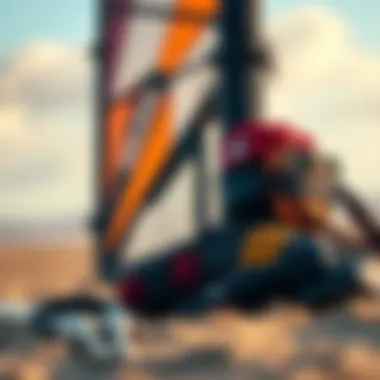
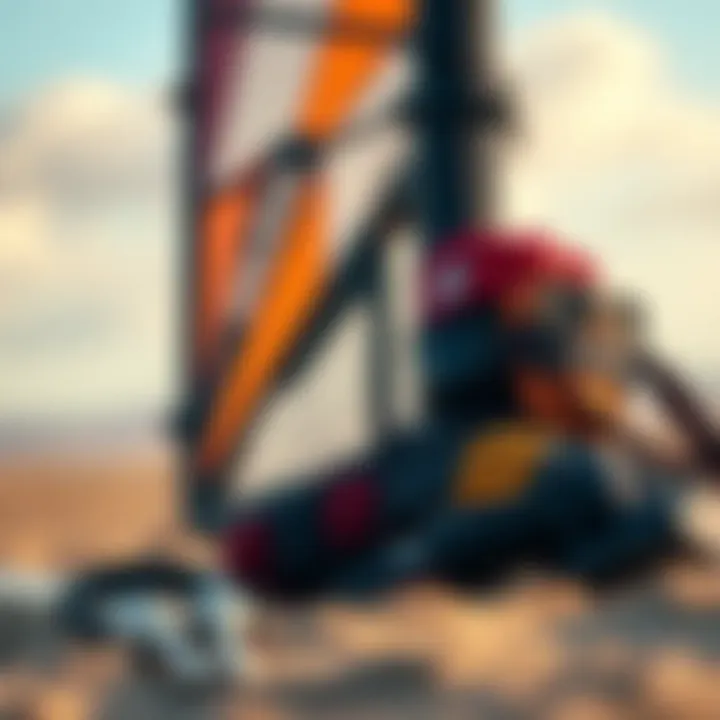
- Beginner Riders: If you’re new to the game, look for kites that have vast wind ranges and offer great stability. Brands such as Cabrinha or Naish provide entry-level models designed for novices. Typically, these kites are more forgiving and deliver consistent performance, making it easier for you to progress through the learning curve.
- Intermediate Riders: If you’ve logged some hours on the water and have grasped the basics, consider experimenting with kites that offer precision control. A model like the F-One Rocket may better suit your evolving skills, allowing for some progression toward advanced tricks while still being forgiving in challenging conditions.
- Advanced Riders: Installing confidence over experience, a more seasoned rider would look for kites that promise high performance. Kites from brands like Ozone or Slingshot could be ideal as they offer greater agility and responsiveness, allowing for precise control when executing jumps, spins, and other tricks.
In summation, understanding where you stand in your kiteboarding journey helps you choose a kite that not only complements your skills but also challenges you to improve.
Popular Brands and Models Reviewed
In the world of wind foil kites, various brands have made their mark, each offering unique features. Choosing from the myriad of options can feel overwhelming, but some brands stand out for their reliability and innovation. Here’s a glimpse into popular brands and their notable models:
- Cabrinha: Known for their solid construction and innovative designs, Cabrinha offers the Cabrinha Switchblade. It’s perfect for all wind conditions and is favored by both beginners and veterans alike.
- Naish: With a long heritage in kiteboarding, their Naish Boxer is celebrated for its versatility, making it suitable in various riding styles from freestyle to wave riding.
- F-One: A frontrunner in foil technology, their F-One Gravity kites are particularly noteworthy. They feature innovative designs that promise superb lift and stability.
"Choosing the right kite represents more than just picking a color or design; it’s the foundation that will build your kiteboarding skills, providing stability, responsiveness, and the thrill of hitting the water."
- Ozone: If high performance is what you crave, the Ozone Alpha stands out. It’s lightweight and perfect for dynamic riding across various conditions.
- Slingshot: The Slingshot Ghost Whisper deserves a mention, particularly revered for its excellent low-end power and responsiveness, appealing to those who crave aggressive maneuvers.
Kiteboarding Destinations for Wind Foil Kites
Kiteboarding destinations hold great significance in the realm of wind foiling. The right spot not only enhances the experience but also plays a crucial role in skill development and safety. Whether you're just starting your journey or are a seasoned rider, the locale can greatly affect your performance and enjoyment.
Top Spots for Beginners
For those who are dipping their toes into kiteboarding with foils, there are several ideal locations that cater specifically to novice riders. These spots often boast steady winds, shallow waters, and ample space which makes learning a breeze.
- Lake Michigan: Known for its calm conditions, this lake is perfect for beginners. The shallow waters allow for safe practice and easier recoveries after face plants.
- The Outer Banks, North Carolina: This area offers warm waters and consistent winds throughout the season. Plus, the wide beaches mean there's plenty of space to set up and practice your skills.
- Kite Beach, Cabarete, Dominican Republic: A more tropical option, Kite Beach is famous for its gentle winds and supportive community. There are numerous rentals and schools available to help newcomers.
These locations provide not just favorable conditions but also the community and instruction essential for a successful start in wind foil kiting.
Advanced Locations for Experienced Riders
Once a kiteboarder has honed their skills, it’s time to tackle spots that provide a bit more challenge. Advanced locations often feature stronger winds, varied water conditions, and obstacles that let experienced riders push the boundaries of their techniques.
- Maui, Hawaii: Renowned for its dynamic conditions, Maui offers a mix of waves and flat water depending on where you choose to ride. With vibrant scenery and consistently high winds, it’s a favorite amongst seasoned kiteboarders.
- Hatteras Island, North Carolina: Known for its powerful winds and the diversity of kiteable areas, Hatteras challenges experienced riders to test their limits. The varied geography presents opportunities for both flatwater riding and wave runs.
- Cape Town, South Africa: This iconic destination is famous for its strong winds, especially in the summer months. Riders here can experience everything from exciting waves to serene lagoons, allowing for an all-encompassing kite foil experience.
Choosing the right destination can make all the difference in your kiteboarding journey. A beginner should find a safe environment to learn while more advanced riders need to constantly seek out conditions that will keep pushing them to expand their skills. Each of these renowned spots offers not just great winds but also a community of like-minded individuals ready to share experiences and advice.
"The thrill of kiteboarding lies in harnessing the wind. It’s not just about how to ride, but where to ride that counts."
Thus, exploring the world of wind foiling shouldn’t just be about personal progression; it should also involve discovering the stunning locations that elevate the sport to its fullest potential.
Future Trends in Wind Foil Kiteboarding
As with any sport, kiteboarding finds itself in a constant state of evolution, driven by innovations in technology and changing environmental conditions. The exploration of future trends in wind foil kiteboarding is not merely about examining new materials or equipment but understanding how these developments can redefine the experience on the water. Emphasizing advancements ensures that both newcomers and seasoned kiteboarders stay abreast of improvements in performance, safety, and sustainability.
Innovations in Kite Design and Technology
Recent years have seen remarkable advancements in kite design and technology. Manufacturers are no longer limited to conventional materials but are now integrating cutting-edge composites and nanotechnology to create lighter, more durable kites. For instance, brands like Duotone and Cabrinha have introduced models featuring high-modulus fibers that enhance strength without compromising weight.
Additionally, smart kites are making headway, equipped with sensors that can provide real-time feedback on performance metrics such as speed, lift, and wind conditions. Such innovations can significantly enhance user experience, allowing riders to make data-driven adjustments on the go. Moreover, adjustable profiles in newer kite models are proving beneficial for altering the kite's performance depending on wind conditions or rider skill level. This flexibility opens doors to a broader audience, accommodating those who enjoy a leisurely ride just as much as thrill-seekers aiming for high-octane tricks.
"Staying ahead of trends isn't just about performance; it's about enhancing the connection between rider and water, embracing the elements with newfound intelligence."
Environmental Considerations and Sustainability
With an increasing global consciousness regarding environmental issues, the kiteboarding community is gradually shifting toward more sustainable practices. This includes the use of biodegradable materials and eco-friendly manufacturing processes, which many companies are starting to adopt. Kiteboarders are encouraged to opt for brands that adhere to sustainable practices, supporting an industry that is aware of its ecological footprint.
The role of recycling can’t be overlooked either. Some enthusiasts have taken initiatives to recycle or repurpose old kites and gear, mitigating waste while fostering community. Programs that facilitate the collection of used kites help in their reprocessing, leading not only to environmental benefits but also to innovative upcycling solutions.
Sustainability isn’t just a buzzword. It’s about creating a future where wind foil kiteboarding can thrive without compromising the environment on which the sport depends. Investing in sustainable practices will likely appeal to a more environmentally-conscious audience, ensuring that kiteboarding remains accessible for future generations.
End and Final Thoughts
As we draw the curtain on this exploration into wind foil kites, it becomes clear that this sport is more than just a recreational activity; it is an evolving passion that intertwines technology and nature. The journey of kiteboarding through the lens of foiling has totally changed the landscape for both amateurs and long-time enthusiasts alike. These kites have redefined not only how we engage with wind and water but also the limits of what is possible in this exhilarating sport.
Reflecting on the Growth of the Sport
Over recent years, kiteboarding has transformed significantly, and wind foiling stands at the forefront of this evolution. What was once an avant-garde concept has now morphed into a mainstream activity, attracting a diverse crowd, from thrill-seeking young adults to families looking for fun on the water. The accessibility of equipment, including wind foil kites, has contributed to this shift. Furthermore, advancements in technology allow for a wider range of riders to experience the thrill of foiling, even those who may have felt intimidated by traditional kiteboarding.
- The surge in social media has also fueled this growth, as athletes share their achievements and inspire others.
- Local kiteboarding communities are popping up everywhere, fostering camaraderie and encouraging newcomers to take the plunge.
These changes underscore the sport’s dynamic nature, reminding us that kiteboarding is not just a pastime; it's a lifestyle that continuously evolves.
Encouraging Responsible Practices
As thrilling as kiteboarding can be, it is imperative to approach the sport with a sense of responsibility. Engaging in responsible practices ensures the safety of participants and the preservation of our environments. Here are some key considerations:
- Follow Local Regulations: Every kiteboarding spot has its own set of rules, and respecting them helps maintain harmony among water users.
- Clean Up After Yourself: Leaving behind only footprints—or in this case, your kite, board, and gear—ensures that sites remain enjoyable for others.
"A responsible kiteboarder not only cares for their own safety but also for the communities around them."
- Educate Others: Share lessons learned and experiences with newcomers to promote safety and respect on the water.
Wind foiling is an adventure, but it’s also a privilege. Practicing responsible kiteboarding helps to ensure that future generations will be able to enjoy this thrilling sport in pristine conditions. In essence, embracing the exhilarating experience of wind foil kites comes hand in hand with the responsibility of nurturing our beautiful natural playgrounds.



